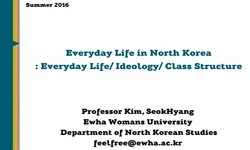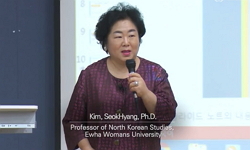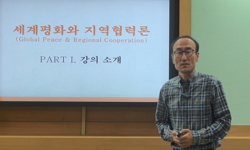Since the end of the 1950-1953 Korean War, many scholars and policymakers have expressed concern about the possibility of another conflict on the peninsula. In certain respects, the post-1953 North-South Korea relationship resembles the Cold War t...
http://chineseinput.net/에서 pinyin(병음)방식으로 중국어를 변환할 수 있습니다.
변환된 중국어를 복사하여 사용하시면 됩니다.
- 中文 을 입력하시려면 zhongwen을 입력하시고 space를누르시면됩니다.
- 北京 을 입력하시려면 beijing을 입력하시고 space를 누르시면 됩니다.

On the Likelihood of Peace and War on the Korean Peninsula: A Causal Loop Analysis = On the Likelihood of Peace and War on the Korean Peninsula: A Causal Loop Analysis
한글로보기https://www.riss.kr/link?id=A82388106
- 저자
- 발행기관
- 학술지명
- 권호사항
-
발행연도
2009
-
작성언어
Korean
- 주제어
-
KDC
028.05
-
등재정보
KCI등재후보
-
자료형태
학술저널
- 발행기관 URL
-
수록면
5-25(21쪽)
-
KCI 피인용횟수
0
- 제공처
-
0
상세조회 -
0
다운로드
부가정보
다국어 초록 (Multilingual Abstract)
Since the end of the 1950-1953 Korean War, many scholars and policymakers have expressed concern about the possibility of another conflict on the peninsula. In certain respects, the post-1953 North-South Korea relationship resembles the Cold War that existed between the United States and the Soviet Union, 1945-1990. Although a “hot” never occurred, peace was never guaranteed. By looking at international theories (i.e., realism and liberal theory) and by utilizing casual-loop diagram analysis, the main purpose of this research is to explore on the likelihood of peace and war on the Korean peninsula. First, several factors (e.g., economic stagnation of North Korea, unstable political systems, and so on) emphasized by realism perspectives are significantly related to the likelihood of conflict between North and South Korea. Conversely, several determinants (e.g., economic assistance to North Korea, inter-dialogue between two Koreas, cultural and social exchange, and so on) emphasized by liberal approaches are significantly related to likelihood of peace on the Korean peninsula. Given the two different interpretations about the likelihood of conflict or peace, it can be argued that a second military action might occur on the Korean peninsula if realism theories are true. However, if practical factors exist on the Korean peninsula, the two Korean can optimistically expect a peaceful reunification in the future, without interference from other countries.
참고문헌 (Reference)
1 Scott D. Sagan, "Why Do States Build Nuclear Weapons?: Three Models in Search of a Bomb" 21 (21): 54-86, 1996
2 Forrester, J. W., "Urban Dynamics" MIT Press 1969
3 Min, H. S., "Toward modeling and simulation of critical national infrastructure interdependencies" 39 (39): 57-71, 2007
4 Kenneth N. Waltz, "Theory of International Politics. Reading" Addison-Wesley 1979
5 Luken, R. A., "The emerging role of benefit-cost analysis in the regulatory process at EPA" 62 : 373-379, 1985
6 Manning, R. A., "The United States in North Korean Foreign Policy in North Korea foreign relations; in the post-cold war era" Oxford university press 140-159, 1998
7 John M. Deutsch, "The New Nuclear Threat" 71 (71): 124-125, 1992
8 Tsoukalis, Loukas, "The New European Economy: The Politics and Economics of Integration" Oxford University Press 1991
9 John R. Oneal, "The Liberal Peace: Interdependence, Democracy, and International Conflict, 1950-1985" 33 (33): 11-28, 1996
10 John R. Oneal, "The Classical Liberals Were Right: Democracy, Interdependence, and Conflict, 1950-1985" 41 (41): 267-293, 1997
1 Scott D. Sagan, "Why Do States Build Nuclear Weapons?: Three Models in Search of a Bomb" 21 (21): 54-86, 1996
2 Forrester, J. W., "Urban Dynamics" MIT Press 1969
3 Min, H. S., "Toward modeling and simulation of critical national infrastructure interdependencies" 39 (39): 57-71, 2007
4 Kenneth N. Waltz, "Theory of International Politics. Reading" Addison-Wesley 1979
5 Luken, R. A., "The emerging role of benefit-cost analysis in the regulatory process at EPA" 62 : 373-379, 1985
6 Manning, R. A., "The United States in North Korean Foreign Policy in North Korea foreign relations; in the post-cold war era" Oxford university press 140-159, 1998
7 John M. Deutsch, "The New Nuclear Threat" 71 (71): 124-125, 1992
8 Tsoukalis, Loukas, "The New European Economy: The Politics and Economics of Integration" Oxford University Press 1991
9 John R. Oneal, "The Liberal Peace: Interdependence, Democracy, and International Conflict, 1950-1985" 33 (33): 11-28, 1996
10 John R. Oneal, "The Classical Liberals Were Right: Democracy, Interdependence, and Conflict, 1950-1985" 41 (41): 267-293, 1997
11 Nathaniel Beck, "Taking Time Seriously: Time-Series-Cross-Section Analysis with a Binary Dependent Variable" 42 (42): 1260-1288, 1998
12 Dong-han Kim, "Systems Thinking" Sun-Hak Sa 2006
13 Ogunlana, S. O., "System dynamics approach to exploring performance enhancement in a construction organization" 129 (129): 528-536, 2003
14 Pavlov, O. V., "Stability in a superpower-dominated global economic system" 39 (39): 491-500, 2005
15 Castillo, D., "Simulation of common pool resource field experiments: A behavioral model of collective action" 55 (55): 420-436, 2005
16 Richardson, George P., "Problems with causal-loop diagrams" 2 (2): 158-170, 1986
17 George Shultz, "Preventing the Proliferation of Nuclear Weapons" 84 (84): 17-21, 1984
18 Keohane, Rober O, "Power and Interdependence Revisited" 41 (41): 725-753, 1987
19 Mohapatra, P. K. J., "Policy analysis for growth of a new technology product" 43 (43): 19-45, 1993
20 Robert Jervis, "Perception and Misperception in International Politics" Princeton University 1976
21 Marquez, A. C., "Operational and financial effectiveness of e-collaboration tools in supply chain integration" 159 (159): 348-363, 2004
22 Michael M. May, "Nuclear Weapons Supply and Demand" 82 (82): 526-537, 1994
23 Kim, K. D., "North Korean’s foreign policy toward the U.S in North Korean foreign policy" Seoul Press 175-210, 1995
24 Zeev Maoz, "National Choices and International Processes" Cambridge University Press 1990
25 Taylor, K., "Modelling the feedback effects of reconfiguring health services" 56 (56): 659-675, 2005
26 Bockermann, A., "Modelling sustainability: Comparing an econometric (PANTA RHET) and a systems dynamics model (SuE)" 27 (27): 189-210, 2005
27 Kenneth N. Waltz, "Man, the State, and War: A Theoretical Analysis" Columbia University Press 1954
28 Solomon W. Polachek, "Liberalism and Interdependence: Extending the Trade-Conflict Model" 36 (36): 405-422,
29 Harvey, J. T., "International capital and Mexican development: A system dynamics model" 35 (35): 439-449, 2001
30 David C. Kang., "International Relations Theory and the Second Korean War" 47 : 301-324, 2003
31 Keohane, Robert O., "International Interdependence and Integration in Handbook of Political Science Vol. 8" Addison-Wesley 363-414, 1975
32 Lindmark, S., "Innovation system dynamics in the Swedish telecom sector" 8 (8): 46-66, 2006
33 William Reed, "Information, Power, and War" 97 (97): 633-641, 2003
34 Kummerow, M., "Information and communication technology in the real estate industry: Productivity, industry structure and market efficiency" 29 (29): 173-190, 2005
35 Forrester, J. W., "Industrial dynamics" MIT Press 1961
36 Powell, J. H., "Identifying strategic action in highly politicized contexts using agent-based qualitative system dynamics" 56 (56): 787-798, 2005
37 David Bearce, "Grasping the Commercial Institutional Peace" 47 : 347-370, 2003
38 Katherine Barbieri, "Globalization and Peace: Assessing New Directions in the Study of Trade and Conflict" 36 (36): 387-404, 1999
39 Brailsford, S. C., "Emergency and on-demand health care: Modelling a large complex system" 55 (55): 34-42, 2004
40 Katherine Barbieri, "Economic Interdependence: A Path to Peace of a Source of International Conflict?" 33 : 29-49, 1996
41 Croom, S., "E-service: Enhancing internal customer service through e-procurement" 14 (14): 539-555, 2003
42 Kim, D. H, "Dynamics of Policy Persuasion: Cause vs. Outcome" 1 (1): 52-67, 2001
43 Shi, T., "Developing effective policies for the sustainable development of ecological agriculture in China: The case study of Jinshan County with a systems dynamics model" 53 (53): 223-246, 2005
44 Assimakopoulos, N. A., "Designing a virtual enterprise architecture using structured system dynamics" 25 (25): 13-29, 2006
45 Jack S. Levy, "Declining Power and the Preventive Motivation for War" 40 : 82-107, 1987
46 Conrad, S. H., "Critical national infrastructure reliability modeling and analysis" 11 (11): 57-71, 2006
47 Robert Jervis, "Cooperation Under the Security Dilemma" 30 (30): 167-214, 1978
48 Mark Gasiorowski, "Conflict and Interdependence: East-West Trade and Linkages in the Era of D?tente" 26 (26): 709-729, 1982
49 Kumar, S., "Closed loop supply chains-A study of US and Japanese car industries" 25 (25): 51-70, 2006
50 Lane, D., "Client involvement in simulation model building: Hints and insights from a case study in a London hospital" 6 (6): 105-116, 2003
51 John R. Oneal, "Clear and Clean: The Fixed Effects of the Liberal Peace" 55 (55): 469-485, 2001
52 Sterman, J. D., "Business Dynamics: Systems Thinking and Modeling for a Complex World" Irwin McGraw-Hill 2000
53 John R. Oneal, "Assessing the Liberal Peace with Alternative Specifications: Trade Still Reduces Conflict" 36 (36): 423-442, 1999
54 James D. Morrow, "Arms Versus Allies: Trade-Offs in the Search for Security" 47 (47): 207-233, 1993
55 Jan, T.-S., "A four-role model of the automotive industry development in developing countries: A case in Taiwan" 55 (55): 1145-1255, 2004
56 Lee, T. -L., "A dynamic analytic approach to national innovation systems: The IC industry in Taiwan" 34 (34): 425-440, 2005
57 Kwak, S. M, "A System Dynamics Model for Negotiation Strategy Analysis with North Korea" 1 (1): 6-31, 2000
58 Ganltung, Johan, "A Structural Theory of Integration" 5 : 375-395, 1968
동일학술지(권/호) 다른 논문
-
물류전문인력 양성과 고용 연계 분석을 위한 시뮬레이션 모델 개발
- 한국시스템다이내믹스학회
- 이재원 ( Jae Won Lee )
- 2009
- KCI등재후보
-
- 한국시스템다이내믹스학회
- 김동환 ( Dong Hwan Kim )
- 2009
- KCI등재후보
-
교통법규 위반자에 대한 사면과 교통사고 발생 간의 인과순환적 관계에 대한 연구
- 한국시스템다이내믹스학회
- 최남희 ( Nam Hee Choi )
- 2009
- KCI등재후보
-
- 한국시스템다이내믹스학회
- 곽찬영 ( Chan Yeong Kwak )
- 2009
- KCI등재후보
분석정보
인용정보 인용지수 설명보기
학술지 이력
| 연월일 | 이력구분 | 이력상세 | 등재구분 |
|---|---|---|---|
| 2026 | 평가예정 | 재인증평가 신청대상 (재인증) | |
| 2020-01-01 | 평가 | 등재학술지 유지 (재인증) |  |
| 2017-01-01 | 평가 | 등재학술지 유지 (계속평가) |  |
| 2013-01-01 | 평가 | 등재 1차 FAIL (등재유지) |  |
| 2010-01-01 | 평가 | 등재학술지 선정 (등재후보2차) |  |
| 2009-01-01 | 평가 | 등재후보 1차 PASS (등재후보1차) |  |
| 2008-01-01 | 평가 | 등재후보학술지 유지 (등재후보1차) |  |
| 2007-01-01 | 평가 | 등재후보학술지 유지 (등재후보1차) |  |
| 2005-06-29 | 학회명변경 | 한글명 : 한국시스템다이네믹스학회 -> 한국시스템다이내믹스학회영문명 : 미등록 -> Korean System Dynamics Society |  |
| 2005-01-01 | 평가 | 등재후보학술지 선정 (신규평가) |  |
학술지 인용정보
| 기준연도 | WOS-KCI 통합IF(2년) | KCIF(2년) | KCIF(3년) |
|---|---|---|---|
| 2016 | 0.55 | 0.55 | 0.55 |
| KCIF(4년) | KCIF(5년) | 중심성지수(3년) | 즉시성지수 |
| 0.56 | 0.48 | 0.599 | 0.39 |




 ScienceON
ScienceON KISS
KISS






